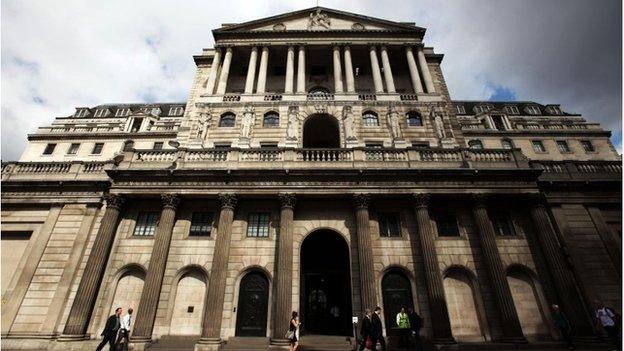Bank outlines economic doomsday scenario
- Published
- comments

It is the first time the Bank has published the stress test scenarios
It is a doomsday scenario most hope Britain will never see - and in fact the country has not seen since World War One.
The Bank of England has laid out the scenario by which it will "stress test" the UK's banks to see if they are secure enough to withstand significant economic and financial shocks.
No one, least of all the Bank, wants a repeat of the events of 2008 again - or at least it wants to be more prepared this time.
The Bank is very keen to insist that this is a "tail risk" scenario - that is, one that is unlikely to happen but is possible.
Seven banks will be tested - HSBC, Barclays, Lloyds Banking Group, the Royal Bank of Scotland, Standard Chartered, the UK arm of Santander and Co-op Bank. One building society, Nationwide, will also have its balance sheet strength scrutinised.
The scenario is this - the UK economy begins to under perform because of weakness in productivity. The value of sterling falls as investors raise concerns about the sustainability of the UK's debt position.
Inflation picks up, peaking at 6.5% by early 2015. Interest rates also start to rise as national output falls, with the economy plunging into recession. Unemployment rises sharply, hitting 12%, a level not seen since the 1980s and early 1990s.
The effect of the economic shocks leads to a collapse in the housing market, with prices falling by up to 35%. Commercial property prices also fall, leaving banks exposed, as they were so horribly six years ago. Poor lending decisions come back to haunt the banks.
Bank opens its doors
The Bank will announce the results of the tests towards the end of the year. They will run alongside European Banking Authority tests which will look at global risks such as an Asia slowdown or a fresh outbreak of the eurozone crisis.
If any banks fail the test, they could be required to raise more capital, lower dividends or clamp down on remuneration.
Many will applaud the Bank for a level of transparency that we have not seen before. For the first time it has published the stress test scenarios, work that used to be done in secret behind the ornate and very firmly closed doors of Threadneedle Street.
The Bank has also committed to publishing the results bank by bank which will allow us all to see where any problems lie.
The housing and commercial property market is rightly at the heart of the test. As an asset class, the UK property market makes up the vast bulk of bank exposure.
Although the Bank insists that a collapse in the housing market is only one of the "shocks" that are being thrown at the banks - the fact it is there is instructive.
Affordability rules for mortgages have already been tightened and last year the Bank did a systemic review of the quality of mortgage assets banks hold which looked at both their value and the amount of capital held against them.
After missing disastrous housing booms and busts in the past, the regulators this time appear to be saying: "We're watching and we will act. Honest."